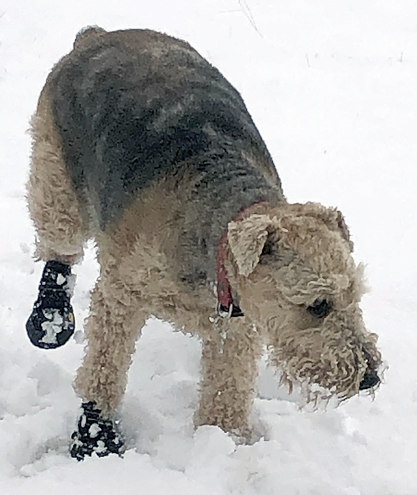By Melissa Bowersock
Spring is here, summer is coming, and people are heading out of doors in droves. I’ve heard from friends who live in Sedona that traffic is abysmal, and of course it’s only a matter of time before Phoenicians head north every Friday evening for a cool weekend in the high country. You’ll be joining them, hiking with your dog? Maybe it’s time to take a refresher in summer hiking safety.

Our first and foremost consideration in the Southwest is always the weather. Because of the dry air (most of the time), our days generally start out cool but then heat up quickly. We two-leggeds can prepare for that by wearing layers of appropriate clothing: comfortable shoes, breezy shirts, hats, etc. We don’t have as many options for our dogs, so we need to safeguard them in other ways.
The easiest way is to be aware of the expected temperature for the day, and plan accordingly. Is it going to hit 100 degrees the day you hike? Plan to hike early in the day and get your dog back to cooler spaces before the high temps spike.
Some years ago, all Phoenix trails were posted closed to dogs when the temps reached 100 degrees and above. This became necessary when some hikers took their dogs out in the high heat and did not heed the signs of distress in their pets; dogs died.
Because our dogs are so loyal and so willing, they will often do our bidding, even when it’s killing them. Some people think, “Well, I’m hot, but I’m doing okay, so my dog must be okay, too.” Think again. Dogs do not have sweat glands anywhere but on the pads of their feet, so they cannot rid their bodies of heat as easily as we can. Panting helps some, but not enough.
Be aware of the signs of heat stroke in dogs: excessive panting, drooling, reddened gums, even vomiting, diarrhea, and uncoordinated movement, and finally… collapse. It’s a horrible way for a dog to die.

I said we could dress according to the weather; so can our dogs. Numerous cooling vests are available. Most of them act like an evaporative cooler: you soak the vest in cool water, let it absorb as much as possible, then wring it out so it’s not dripping. There are others that have pockets for ice packs.
We had two for Annie, one quilted one when she was smaller, and a thinner nylon one when she reached her full size. She never liked putting them on, but I do believe they kept her comfortable. With the evap vests, you can “recharge” them with a little of the water you take with you.
With the hot ground, rocks, and asphalt that surround us, you might also consider booties. Yes, a dog’s pads are pretty tough, but if the ground is too hot for you to walk on it in bare feet, it’s also too hot for your dog. I’ve seen pictures of a dog’s feet with multiple layers of skin burned off on hot asphalt; don’t be that guy.
I bought Annie some snow booties, which could also work for hot surfaces. These have two Velcro straps on each, so they tighten fully and stay on well.

What else should you take with you on your hike? A fully charged cell phone seems like a no-brainer, but every year people get lost and can’t call for help because they’ve forgotten their phones or the phones’ batteries have died. Don’t be a statistic.
The second no-brainer is water. The general guideline is to take one gallon of water per person per day: I would suggest the same for your dog. My Airedale, Annie, is a big drinker, and I always take more water than I think we’ll need. Yes, it’s heavy and yes, it’s bulky, but it’s necessary.
Be a good trail steward and use reusable bottles, not one-use plastic, and don’t depend on natural water sources for your dog. Streams and rivers can develop toxic algae during the hot months, and many of those algae are poisonous to dogs. Here in Utah, the Virgin River has been flagged as having poisonous levels of algae, and even special water filtering systems are not considered safe enough. Better not to chance it.
We get a ton of tourists here in the Southwest, people from northern or eastern states who aren’t familiar with our unique landscape. I’m always amazed at how many people think they are in a big, outdoor Disneyland. These are the ones who put their toddlers on the backs of bison in Yellowstone or start down the Bright Angel Trail into the Grand Canyon wearing flip-flops and with no water.
I would caution people to research the areas they’re hiking and prepare accordingly. Our outdoors, while stunningly beautiful, can be deadly. Heatstroke is a constant summer hazard, along with falling, getting lost, drowning, and lethal wildlife.
By the same token, know your own limits. Hike trails that are within your skill level and stay mindful. There was a viral video a while back of a woman who was taking pictures at the Grand Canyon; she stepped backward for a better view and came within inches of falling off the cliff. Since I’ve been in Utah, I’ve heard several stories of people falling hundreds of feet in Zion.
Our landscape, while awesome, cares not a fig about your safety or the safety of your dog. That’s your responsibility. Take it seriously and have a wonderful, but safe, hike. Your dog will thank you for it.

